A Wide Bandwidth Vivaldi Antenna Suitable for 5G/6G Communication Utilizing a CMOS 0.18 μm Process
Abstract
:1. Introduction
2. Design of Antenna
2.1. Geometry of the Antenna
2.2. Antenna Design
2.3. Antenna Parameterisation Process
3. Antenna Simulation and Measurement
3.1. Simulation and Measurement Results
3.2. Gain and Measurement
4. Discussion
Author Contributions
Funding
Data Availability Statement
Conflicts of Interest
References
- Zhang, K.; Tan, R.; Jiang, Z.H.; Huang, Y.; Tang, L.; Hong, W. A compact, ultrawideband dual-polarized Vivaldi antenna with radar cross section reduction. IEEE Antennas Wirel. Propag. Lett. 2022, 21, 1323–1327. [Google Scholar] [CrossRef]
- Yin, Z.; He, G.; Yang, X.-X.; Gao, S. Miniaturized ultrawideband half-mode Vivaldi antenna based on mirror image theory. IEEE Antennas Wirel. Propag. Lett. 2020, 19, 695–699. [Google Scholar] [CrossRef]
- Wu, B.; Sun, X.-Y.; Zu, H.-R.; Zhang, H.-H.; Su, T. Transparent Ultrawideband Halved Coplanar Vivaldi Antenna with Metal Mesh Film. IEEE Antennas Wirel. Propag. Lett. 2022, 21, 2532–2536. [Google Scholar] [CrossRef]
- Dixit, A.S.; Kumar, S. A survey of performance enhancement techniques of antipodal Vivaldi antenna. IEEE Access 2020, 8, 45774–45796. [Google Scholar] [CrossRef]
- Mustacchio, C.; Boccia, L.; Arnieri, E.; Amendola, G. A gain levelling technique for on-chip antennas based on split-ring resonators. IEEE Access 2021, 9, 90750–90756. [Google Scholar] [CrossRef]
- Baniya, P.; Melde, K.L. Switched beam SIW horn arrays at 60 GHz for 360 reconfigurable chip-to-chip communications with interference considerations. IEEE Access 2021, 9, 100460–100471. [Google Scholar] [CrossRef]
- Shi, X.; Cao, Y.; Hu, Y.; Luo, X.; Yang, H.; Ye, L.H. A high-gain antipodal Vivaldi antenna with director and metamaterial at 1–28 GHz. IEEE Antennas Wirel. Propag. Lett. 2021, 20, 2432–2436. [Google Scholar] [CrossRef]
- Deng, J.-Y.; Cao, R.; Sun, D.; Zhang, Y.; Guo, L.-X. Bandwidth enhancement of an antipodal Vivaldi antenna facilitated by double-ridged substrate-integrated waveguide. IEEE Trans. Antennas Propag. 2020, 68, 8192–8196. [Google Scholar] [CrossRef]
- Cheng, H.; Yang, H.; Li, Y.; Chen, Y. A compact vivaldi antenna with artificial material lens and sidelobe suppressor for GPR applications. IEEE Access 2020, 8, 64056–64063. [Google Scholar] [CrossRef]
- Liu, Z.; Chen, Y.; Yang, S. In-band scattering cancellation techniques for Vivaldi antenna array. IEEE Trans. Antennas Propag. 2021, 70, 3411–3420. [Google Scholar] [CrossRef]
- Lee, W.-W.; Hwang, I.-J.; Jang, B. End-fire Vivaldi antenna array with wide fan-beam for 5G mobile handsets. IEEE Access 2020, 8, 118299–118304. [Google Scholar] [CrossRef]
- Zhang, H.; Wang, J.; Han, Y.; Zhu, R.; Liu, T.; Fu, X.; Liu, C.; Li, Y.; Chu, Z.; Qu, S. Isolation Enhancement for Vivaldi Antennas using Hyperbolic Metasurface. IEEE Trans. Antennas Propag. 2023, 71, 7650–7655. [Google Scholar] [CrossRef]
- Zhu, S.; Liu, H.; Wen, P.; Chen, Z.; Xu, H. Vivaldi antenna array using defected ground structure for edge effect restraint and back radiation suppression. IEEE Antennas Wirel. Propag. Lett. 2019, 19, 84–88. [Google Scholar] [CrossRef]
- Zhou, L.; Tang, M.; Qian, J.; Zhang, Y.-P.; Mao, J. Vivaldi antenna array with heat dissipation enhancement for millimeter-wave applications. IEEE Trans. Antennas Propag. 2021, 70, 288–295. [Google Scholar] [CrossRef]
- Liu, X.; Zhu, Y.; Xie, W. A Miniaturized Wideband Directional Circularly Polarized Antenna Based on Bent Vivaldi Antenna Structure. IEEE Antennas Wirel. Propag. Lett. 2022, 22, 298–302. [Google Scholar] [CrossRef]
- Tianang, E.G.; Elmansouri, M.A.; Filipovic, D.S. Ultrawideband flush-mountable dual-polarized vivaldi antenna. IEEE Trans. Antennas Propag. 2020, 68, 5670–5674. [Google Scholar] [CrossRef]
- Yi, H.; Ozturk, E.; Koelink, M.; Krimmling, J.; Damian, A.A.; Debski, W.; van Zeijl, H.; Zhang, G.; Poelma, R.H. Antenna-in-Package (AiP) Using Through-Polymer Vias (TPVs) for a 122-GHz Radar Chip. IEEE Trans. Compon. Packag. Manuf. Technol. 2022, 12, 893–901. [Google Scholar] [CrossRef]
- Singh, M.; Parihar, M.S. Gain Improvement of Vivaldi MIMO Antenna With Pattern Diversity Using Bi-Axial Anisotropic Metasurface for Millimeter-Wave Band Application. IEEE Antennas Wirel. Propag. Lett. 2022, 22, 621–625. [Google Scholar] [CrossRef]
- Kim, H.; Jang, T.H.; Park, C.S. 60-GHz compact vertically polarized end-fire monopole-based Yagi antenna-in-package for wideband Mobile communication. IEEE Access 2022, 10, 111077–111086. [Google Scholar] [CrossRef]
- Burasa, P.; Djerafi, T.; Wu, K. A 28 GHz and 60 GHz dual-band on-chip antenna for 5G-compatible IoT-served sensors in standard CMOS process. IEEE Trans. Antennas Propag. 2020, 69, 2940–2945. [Google Scholar] [CrossRef]
- Tang, S.-Y.; Chen, J.; Xia, X.; Zhou, P.; Lu, H.; Chang, L.; Cheng, W.; Tao, H.; Zheng, S.; Li, Z. Terahertz On-Chip Aperture Antenna with through Substrate Vias for Enhanced Gain and Chip-Size Insensitivity in InP Technology. IEEE Trans. Antennas Propag. 2023, 71, 7184–7195. [Google Scholar] [CrossRef]
- Kong, S.; Shum, K.M.; Yang, C.; Gao, L.; Chan, C.H. Wide impedance-bandwidth and gain-bandwidth terahertz on-chip antenna with chip-integrated dielectric resonator. IEEE Trans. Antennas Propag. 2021, 69, 4269–4278. [Google Scholar] [CrossRef]
- Ballesteros, C.; Vega, S.; Santos, M.; Jofre-Roca, L. Short Asymmetrical Inductive Dipole Antenna for Direct Matching to High-Q Chips. IEEE Antennas Wirel. Propag. Lett. 2022, 22, 149–153. [Google Scholar] [CrossRef]
- Yu, Y.; Akhter, Z.; Shamim, A. Ultra-thin artificial magnetic conductor for gain enhancement of antenna-on-chip. IEEE Trans. Antennas Propag. 2022, 70, 4319–4330. [Google Scholar] [CrossRef]

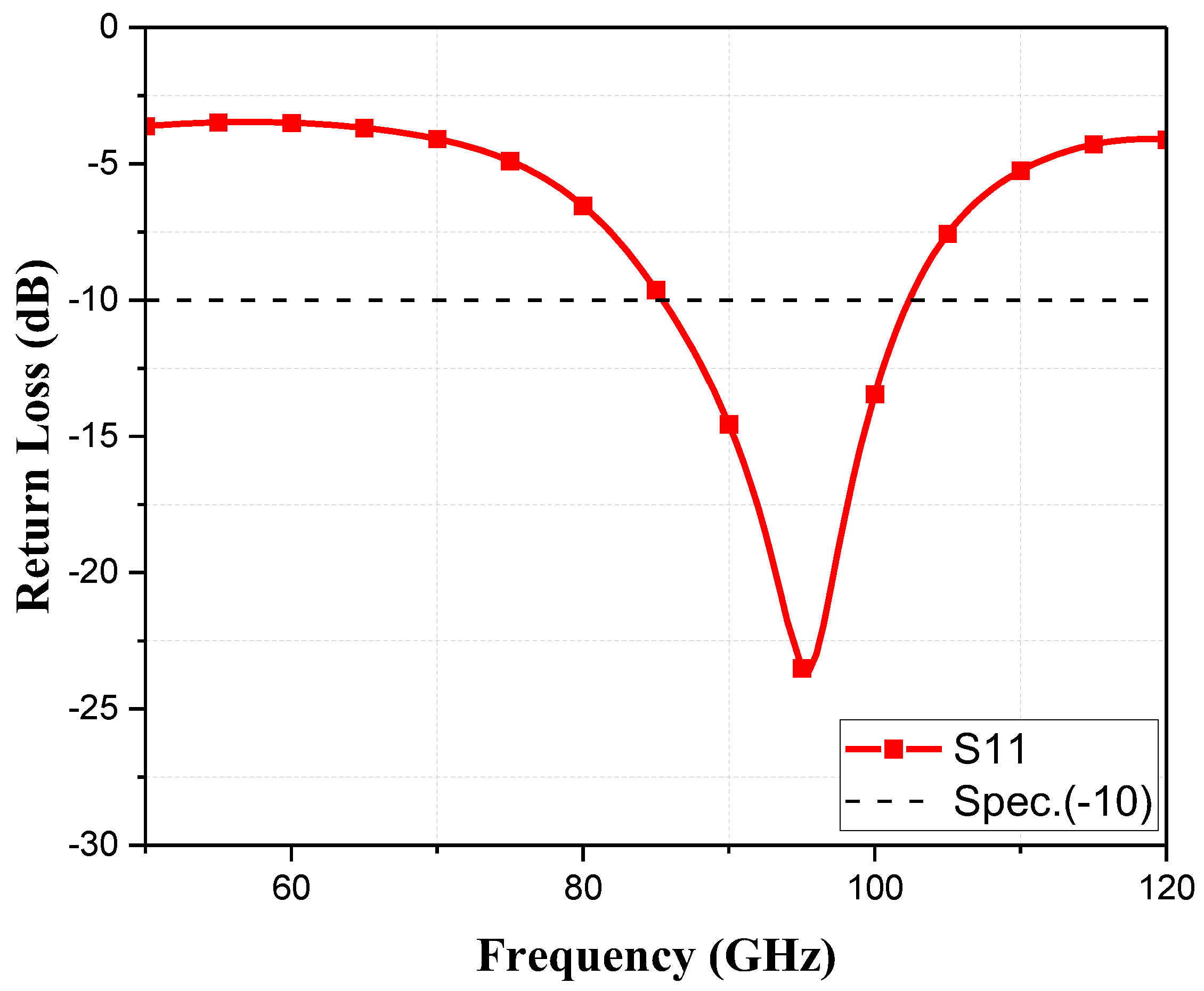
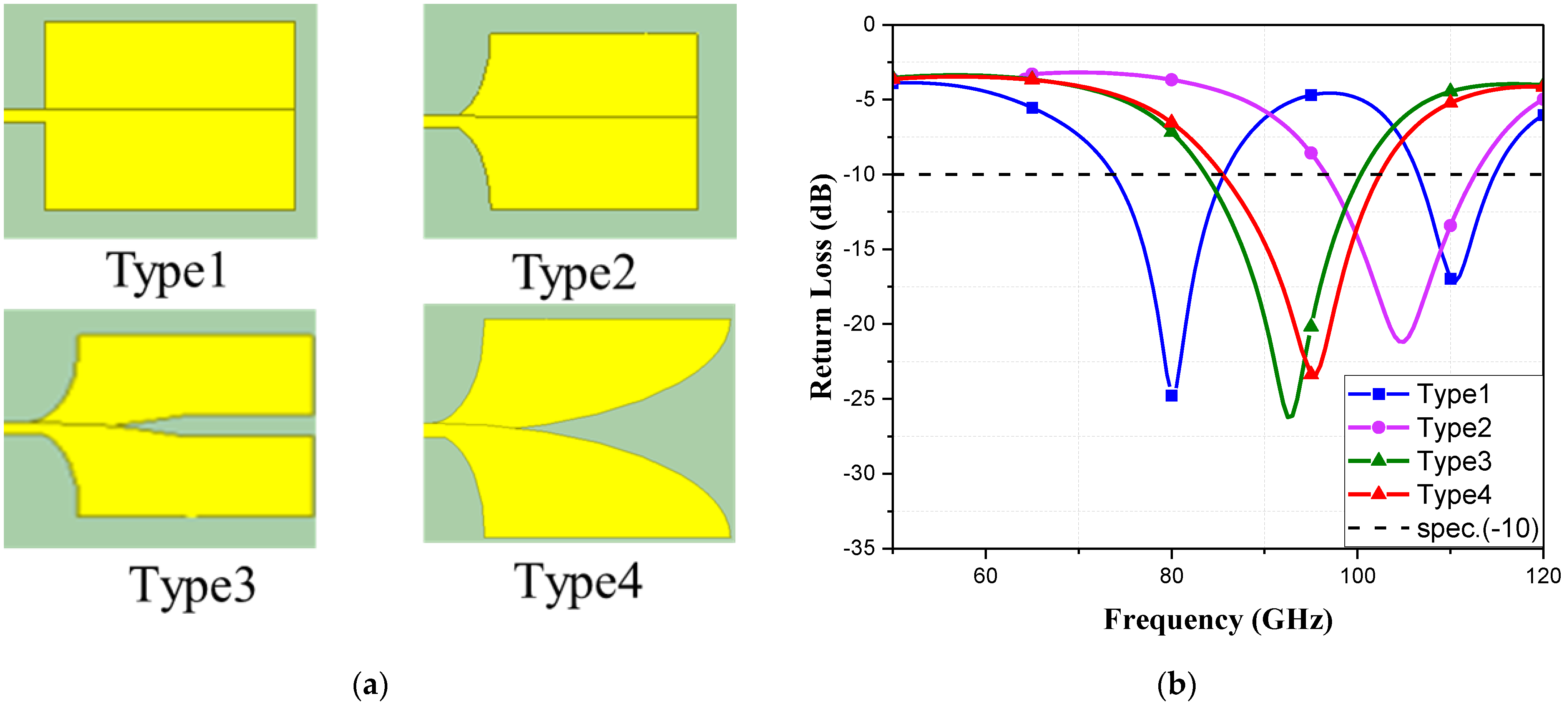
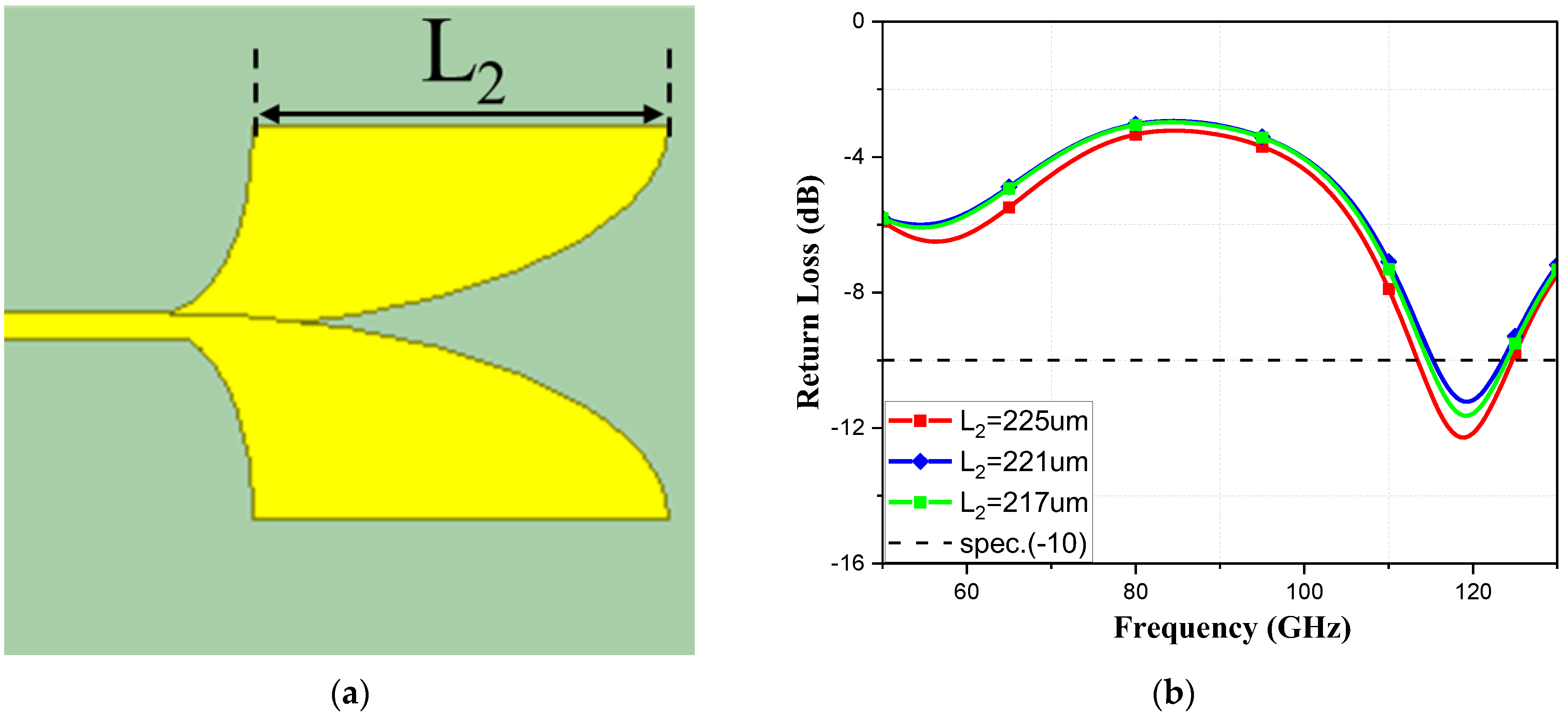

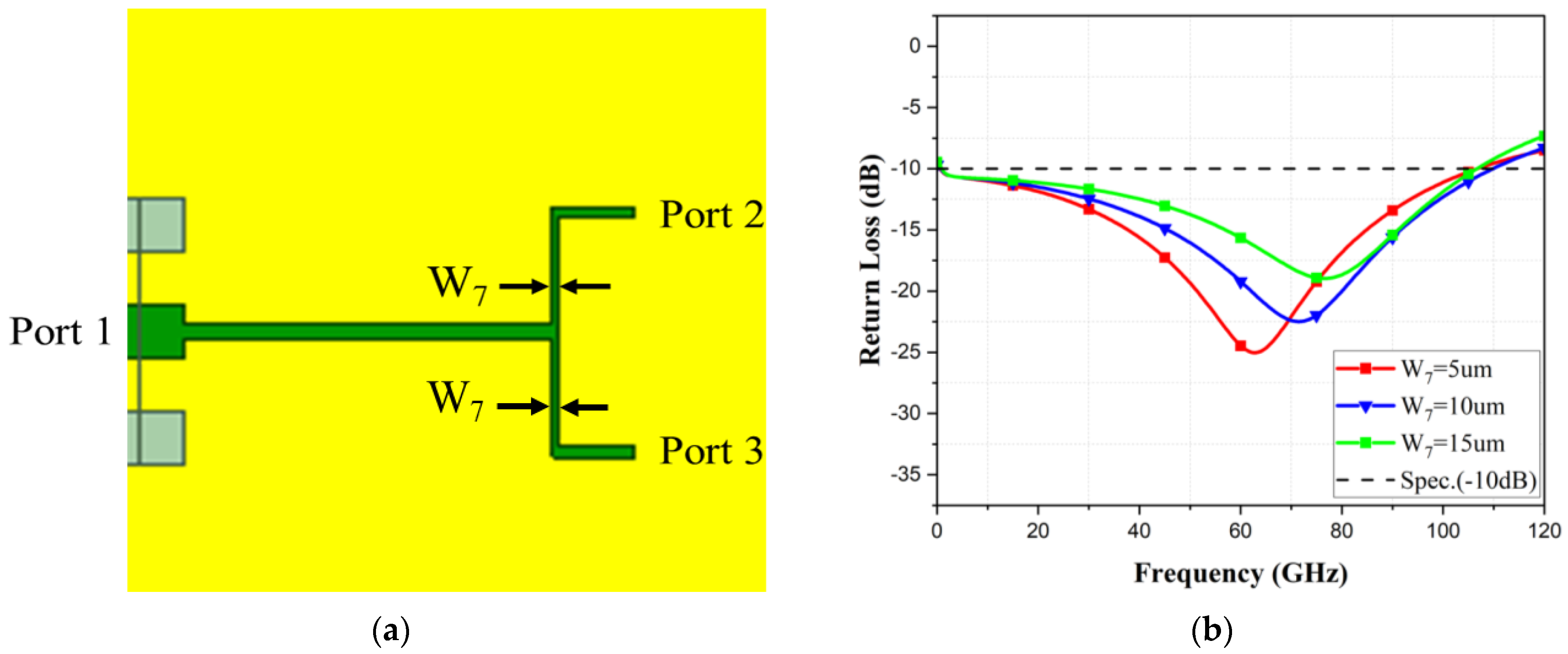
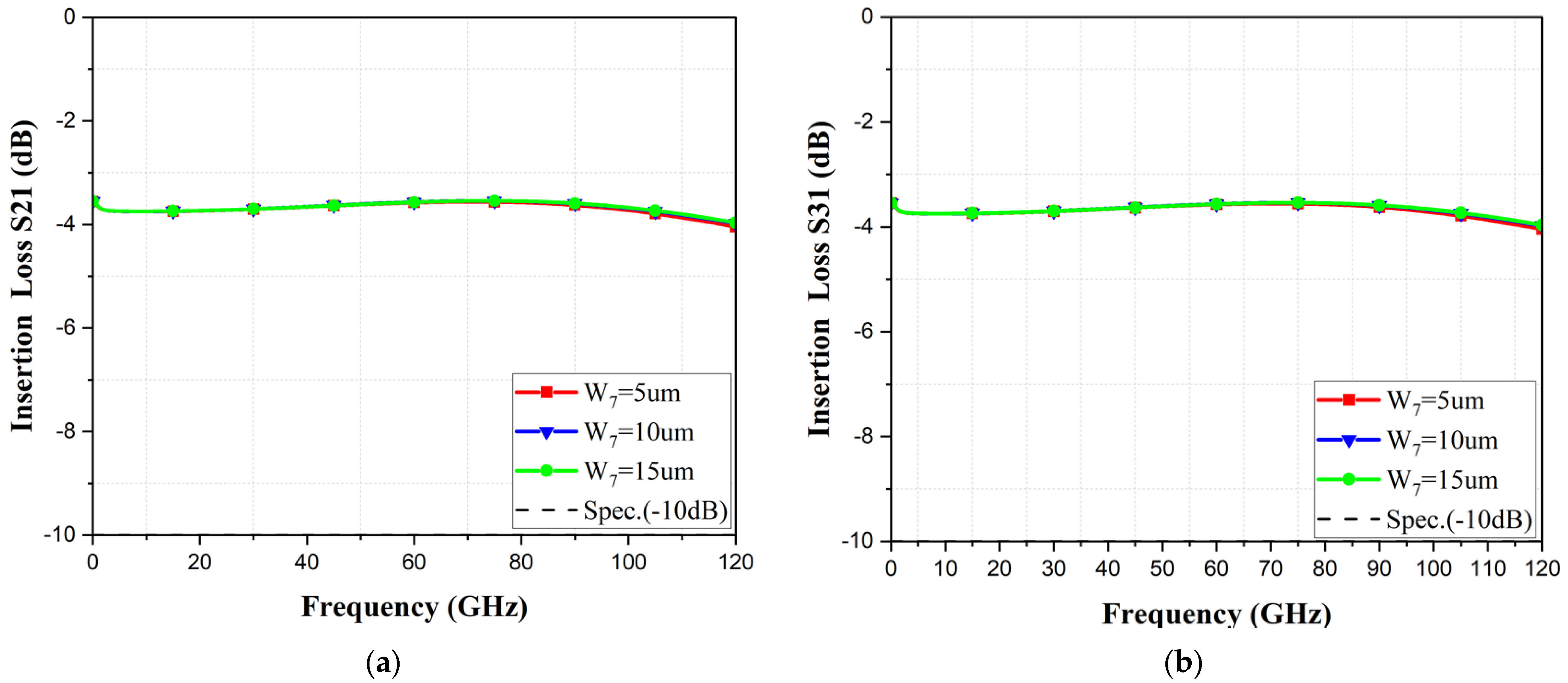
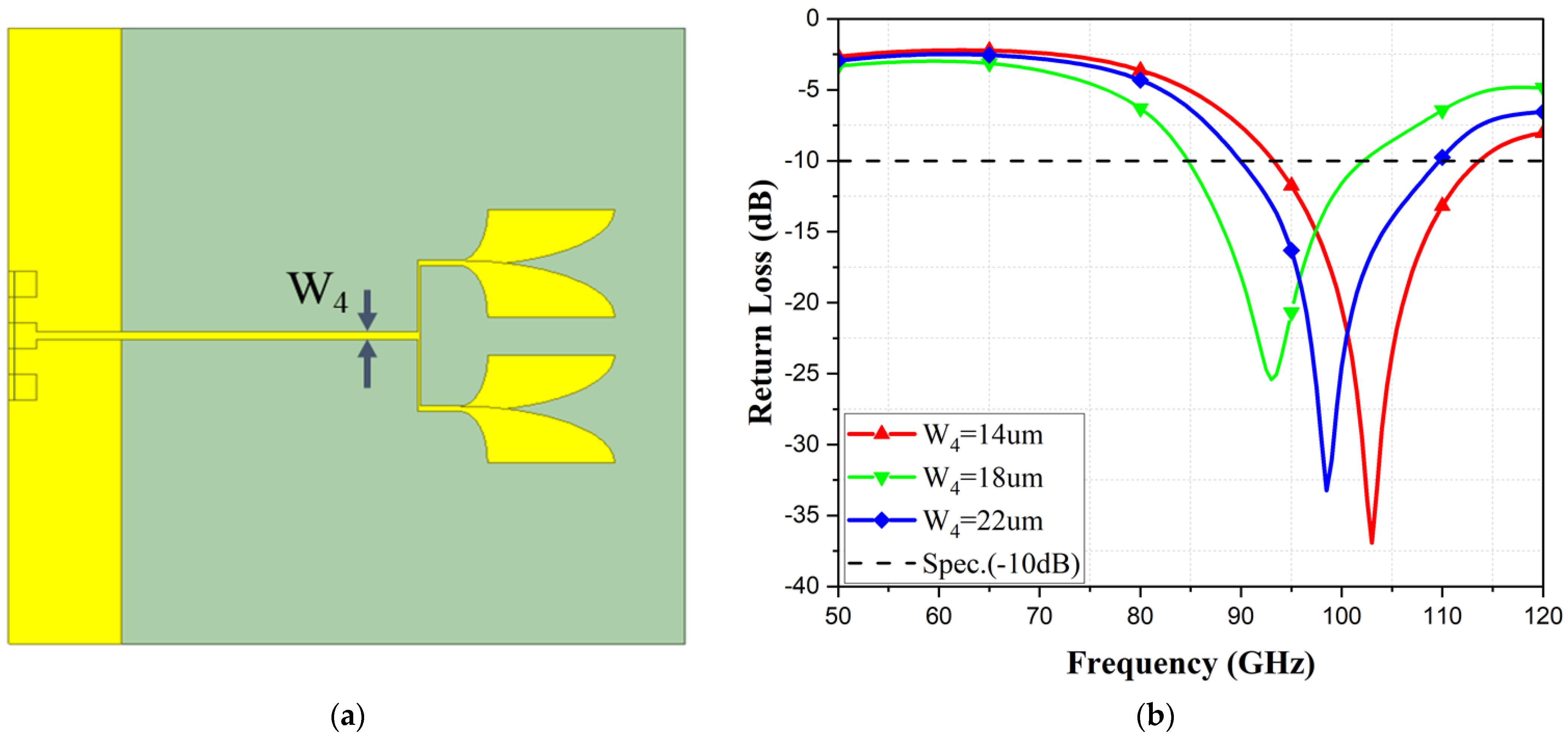
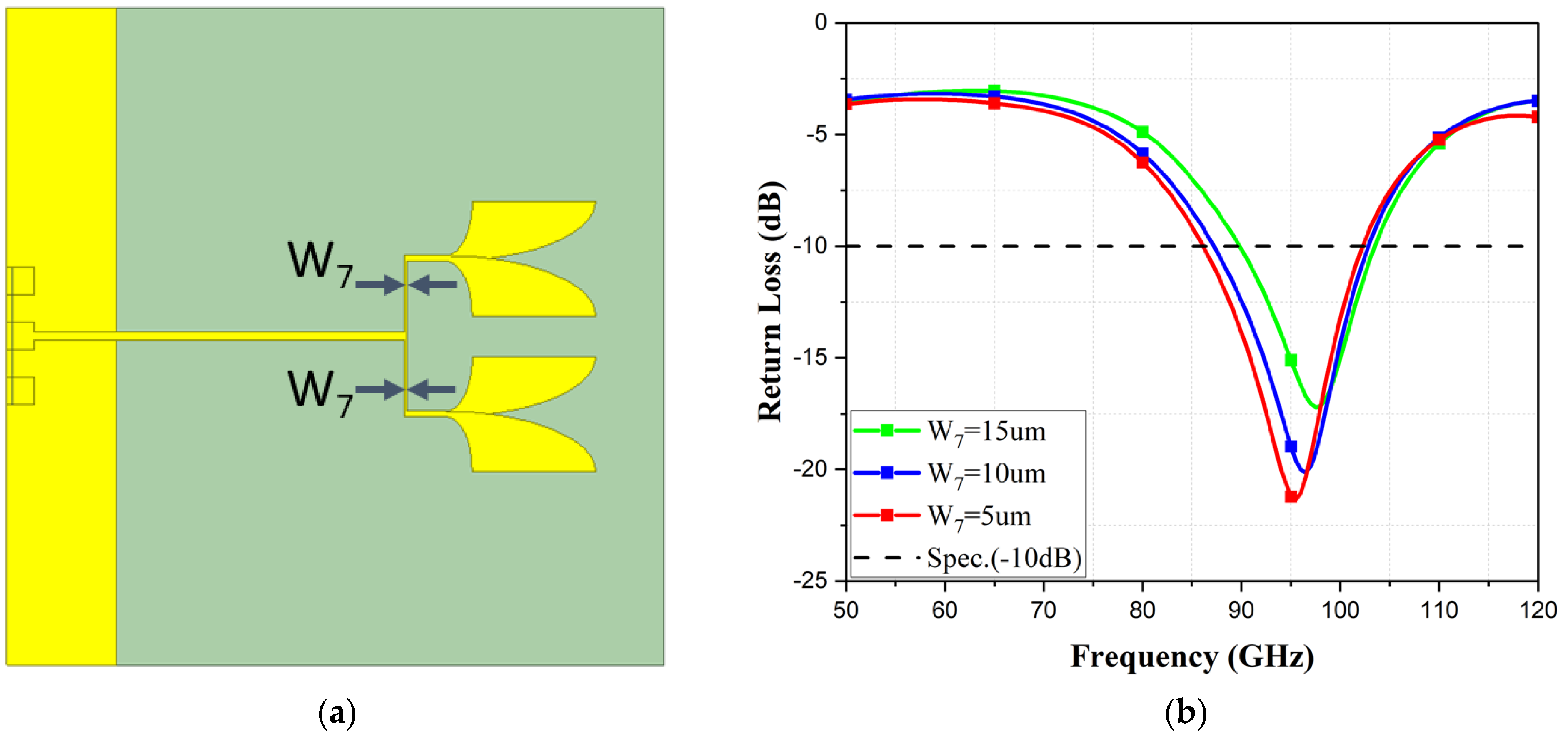

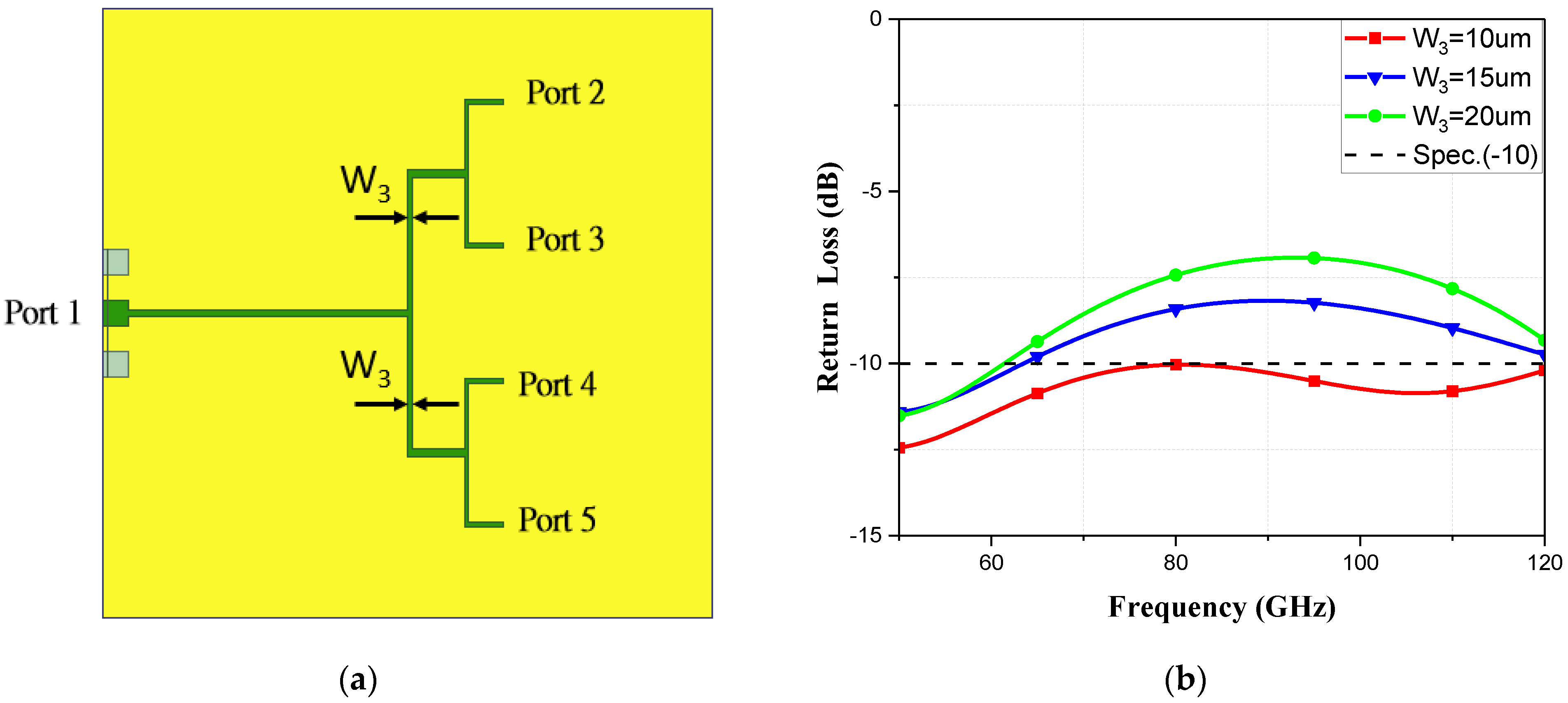
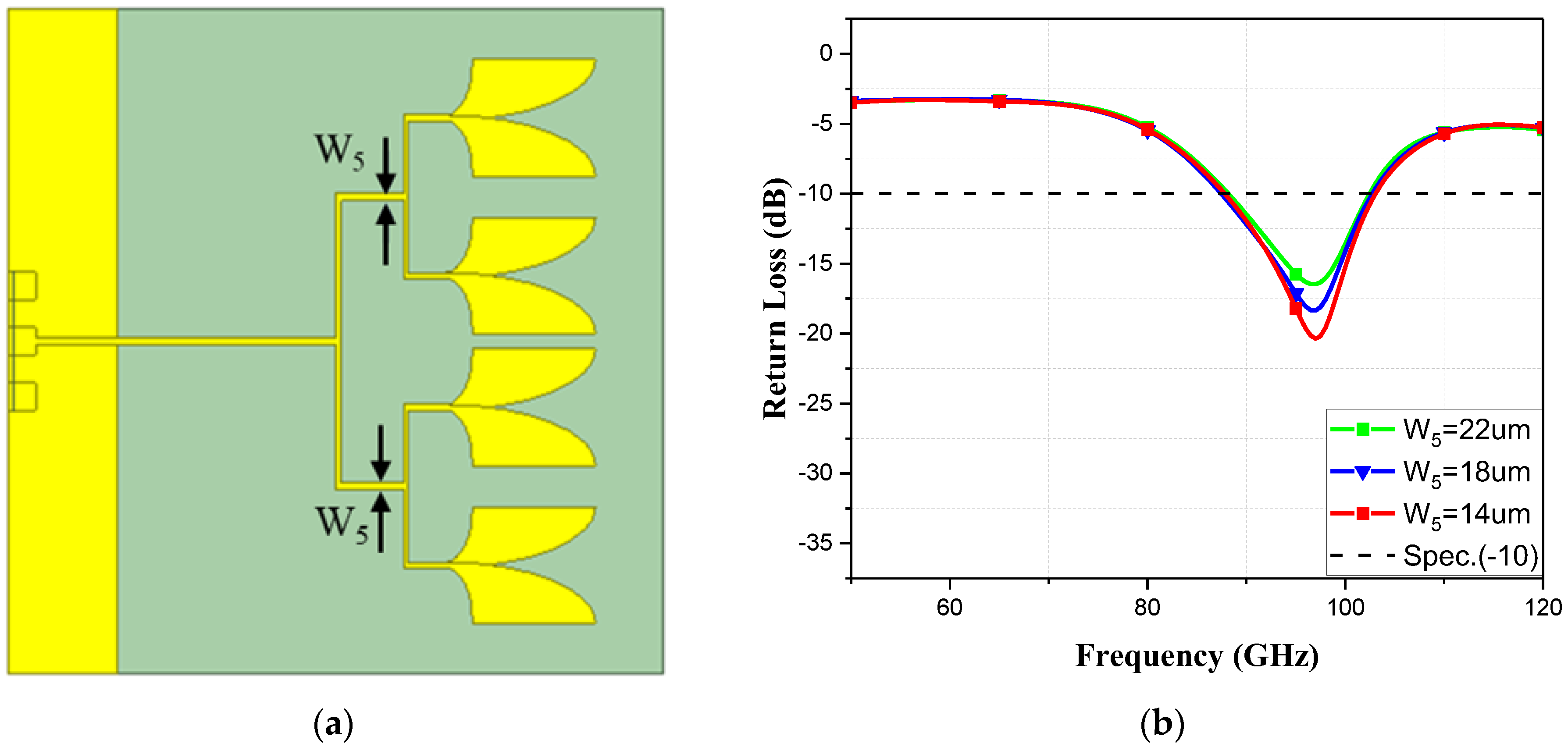



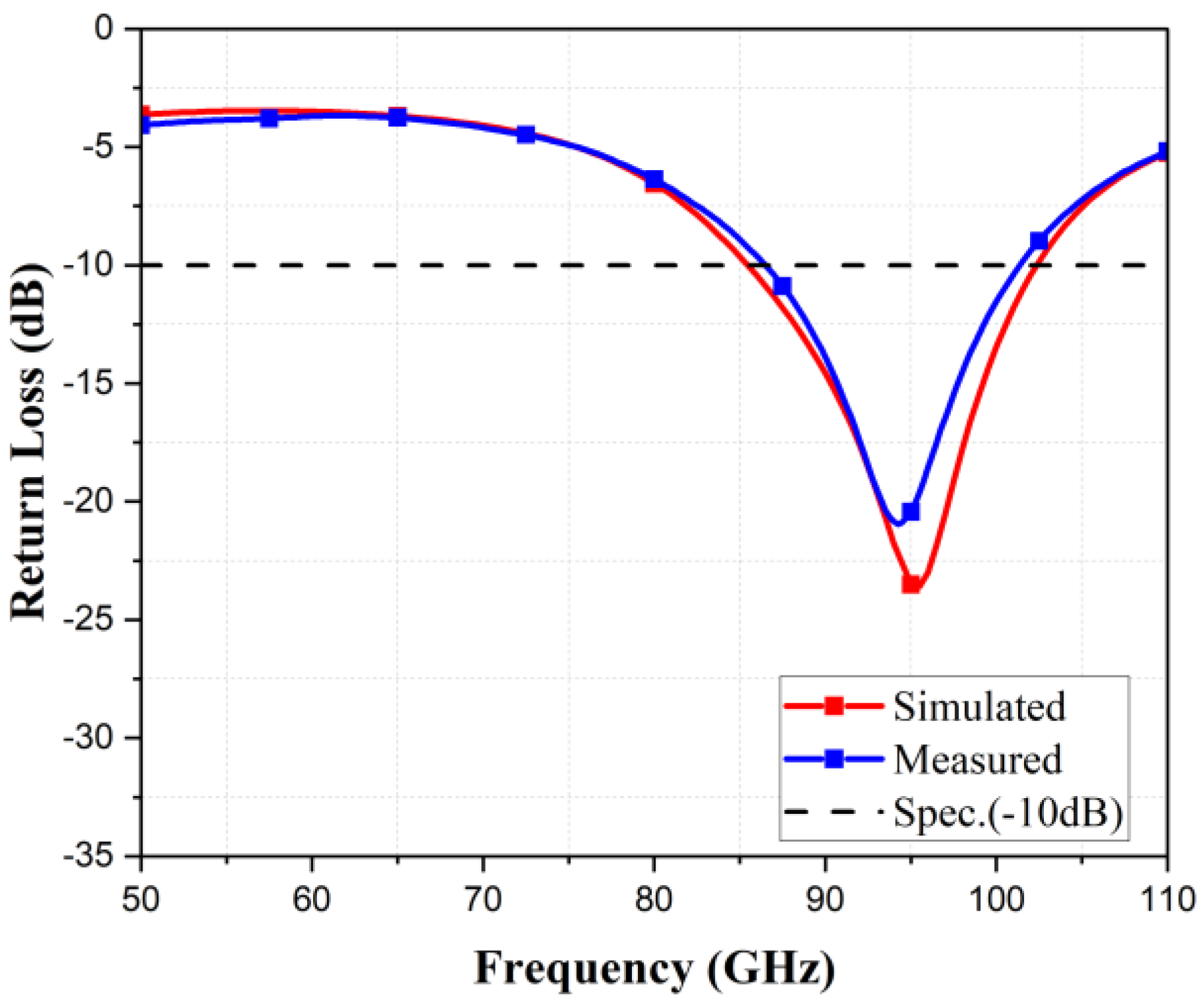
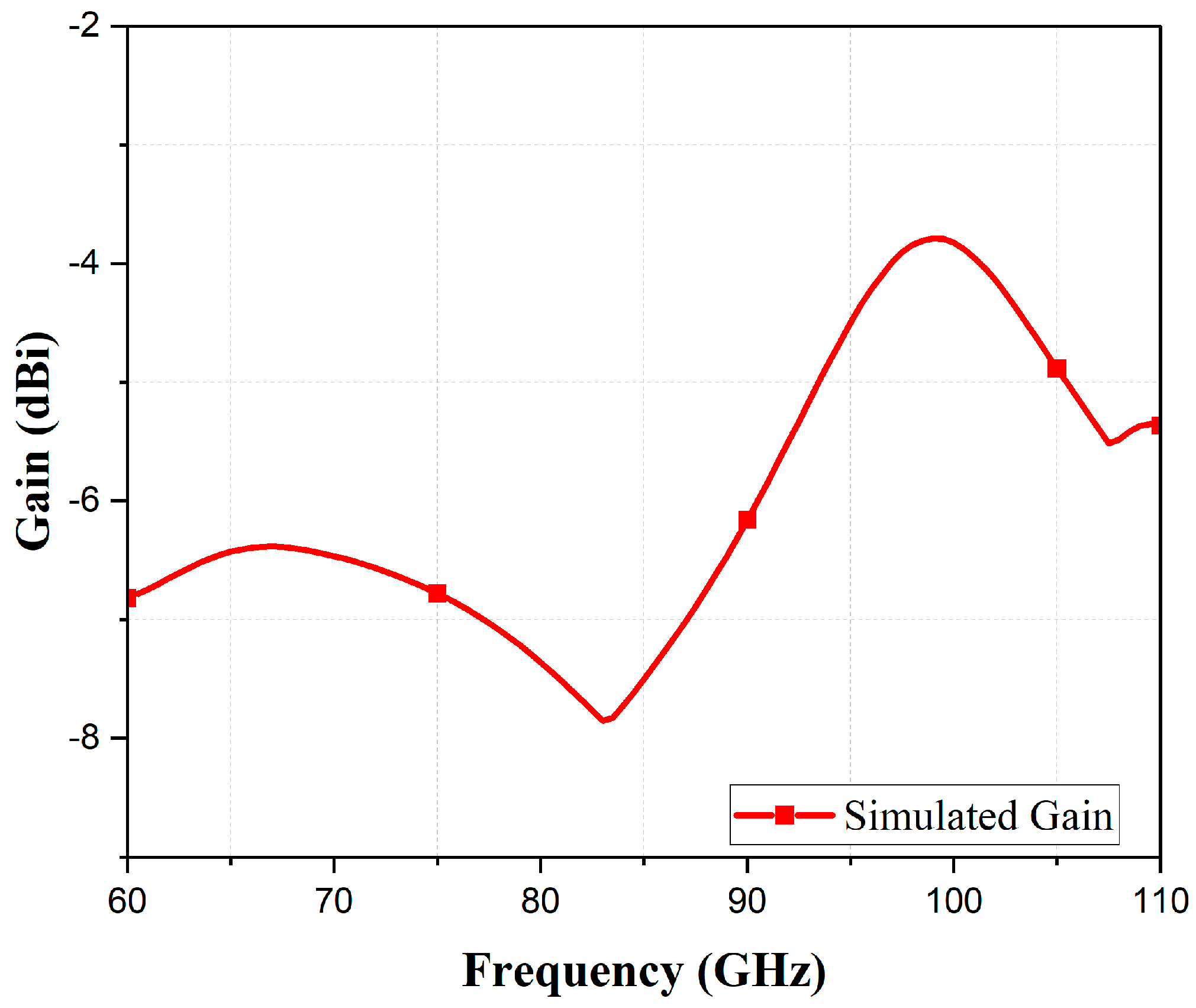

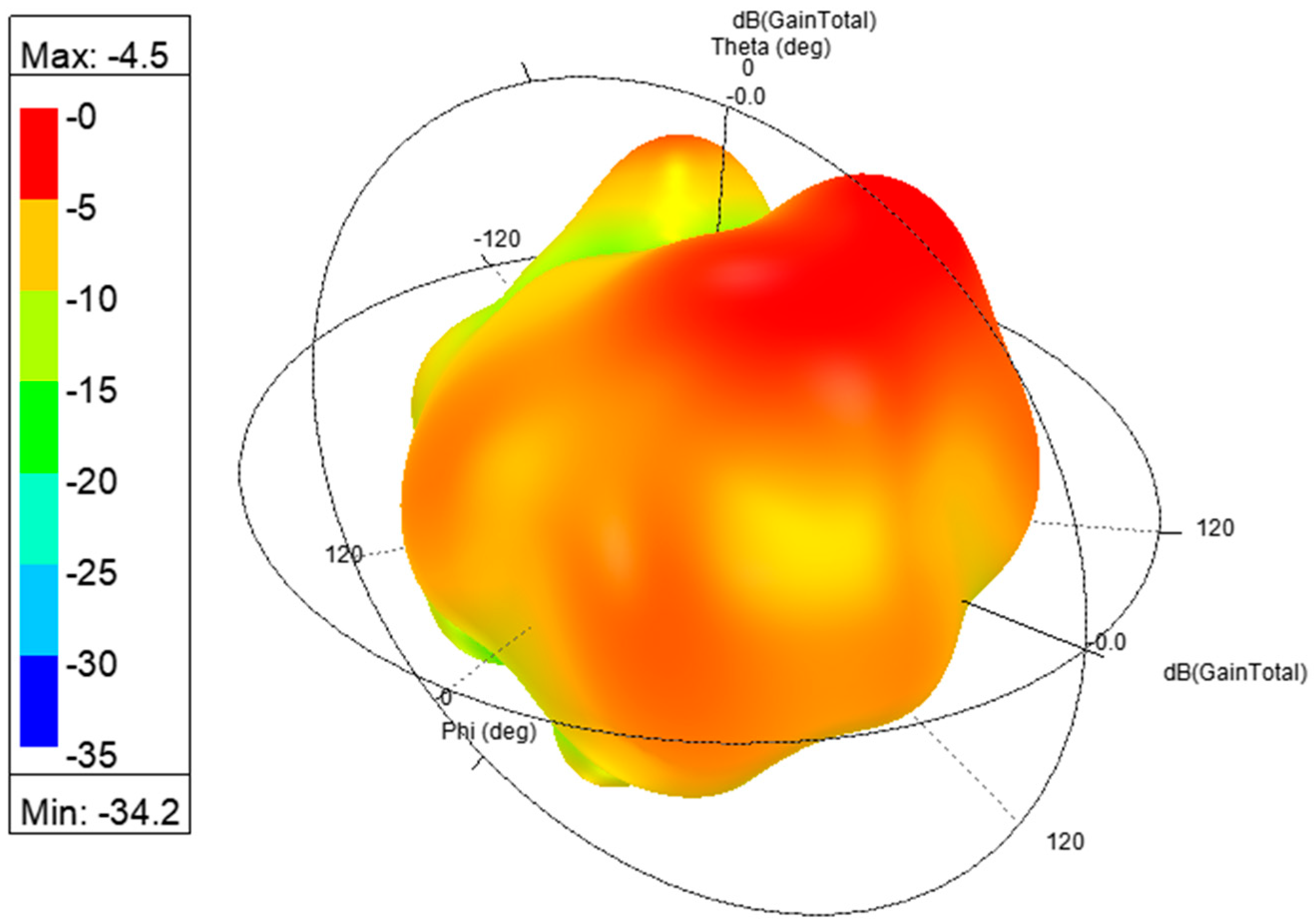

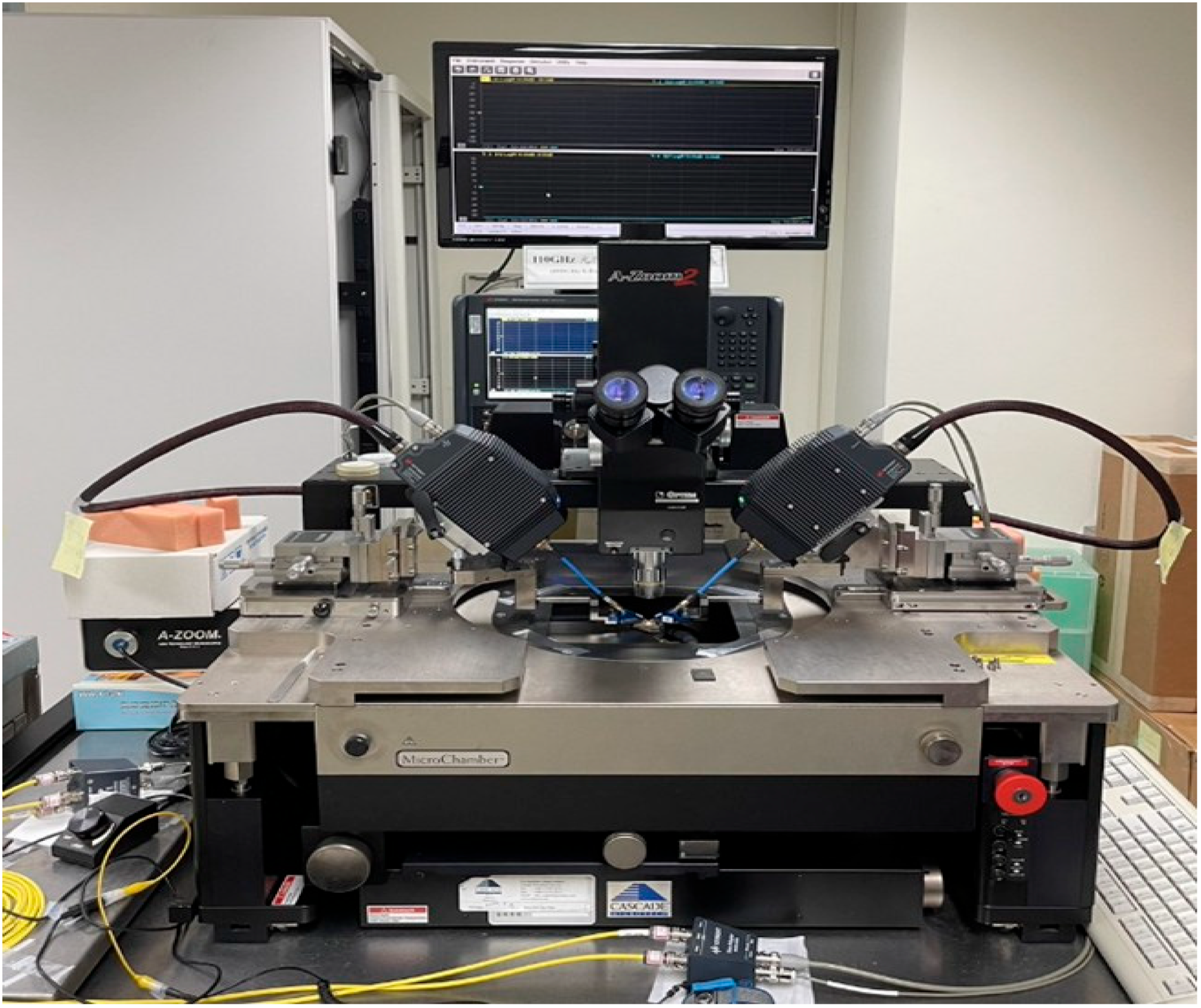
| Length | Value | Width | Value |
|---|---|---|---|
| L1 | 600 | W1 | 210 |
| L2 | 225 | W2 | 125 |
| L3 | 274 | W3 | 10 |
| L4 | 125 | W4 | 14 |
| L5 | 260 | W5 | 14 |
| L6 | 1200 | W6 | 10 |
| L7 | 200 | W7 | 5 |
| References | Antenna Type | * FBW (GHz) | Size (mm2) | Process |
|---|---|---|---|---|
| [5] | Monolithically Integrated antennas | 77–87 | 1.296 × 1.508 | 0.13 μm SiGe BiCMOS |
| [6] | (SNIR) antenna | 57.24–65.88 | N/A | Switching the directive beams of the arrays |
| [24] | System on chip | 93–95 | N/A | CMOS |
| [17] | Trough-polymer Via technology | 120–124.3 | 0.94 × 1.45 | SiGe BiCMOS |
| [19] | Yagi antenna | 57.6–67 | 0.74 × 1.14 | Glass substrate |
| This work | Vivaldi antenna | 85.47–102.4 | 1.2 × 1.2 | 0.18 μm CMOS |
Disclaimer/Publisher’s Note: The statements, opinions and data contained in all publications are solely those of the individual author(s) and contributor(s) and not of MDPI and/or the editor(s). MDPI and/or the editor(s) disclaim responsibility for any injury to people or property resulting from any ideas, methods, instructions or products referred to in the content. |
© 2024 by the authors. Licensee MDPI, Basel, Switzerland. This article is an open access article distributed under the terms and conditions of the Creative Commons Attribution (CC BY) license (https://creativecommons.org/licenses/by/4.0/).
Share and Cite
Chung, M.-A.; Ting, C.-W.; Tseng, K.-C. A Wide Bandwidth Vivaldi Antenna Suitable for 5G/6G Communication Utilizing a CMOS 0.18 μm Process. Telecom 2024, 5, 400-415. https://doi.org/10.3390/telecom5020020
Chung M-A, Ting C-W, Tseng K-C. A Wide Bandwidth Vivaldi Antenna Suitable for 5G/6G Communication Utilizing a CMOS 0.18 μm Process. Telecom. 2024; 5(2):400-415. https://doi.org/10.3390/telecom5020020
Chicago/Turabian StyleChung, Ming-An, Chung-Wu Ting, and Kuo-Chun Tseng. 2024. "A Wide Bandwidth Vivaldi Antenna Suitable for 5G/6G Communication Utilizing a CMOS 0.18 μm Process" Telecom 5, no. 2: 400-415. https://doi.org/10.3390/telecom5020020





